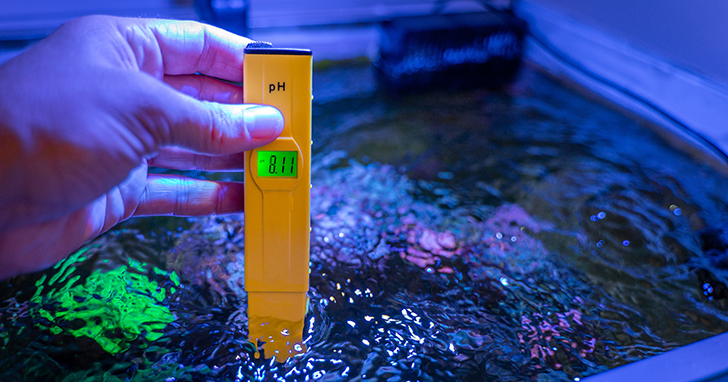Proper Water Parameters for Home Aquariums

The aquarium hobby adds a level of contentment to your life and offers many benefits derived from adding the beauty, interest and relaxation element that stocked aquariums provide. Maintaining proper water parameters is one of the most important responsibilities associated with aquarium keeping. Not only is monitoring the following levels important, but amending aquarium water with salt, conditioners and additives is an important step that helps aquarists meet ideal parameters. Do you know what the water parameters for your home aquarium are? For both freshwater and saltwater (marine) aquariums, read on to find out what LiveAquaria® recommends for each. What do I need to test my freshwater aquarium water for?
TemperatureGiven that not all freshwater fish and invertebrates require the same temperature, there are general recommendations for freshwater fish that replicate temperatures found in their native habitats. pH LevelspH is the measurement of alkalinity or acidity within water. The reading of a 0 is neutral. Levels of 1 to 6 indicate the water is acidic. Readings of 7 to 14 means the water is alkaline. Your water’s Carbonate Hardness must be considered if you wish to adjust your pH because soft water takes changes more readily than hard water does. Ammonia (NH3)Excess ammonia is detrimental to the health of your aquatic life. Keeping ammonia in check is an on-going process as ammonia is continually added to the aquarium through fish waste, and as leftover food and other dead matter decays. Monitoring and amending the water to deal with ammonia is essential. Nitrite (NO2)Nitrite is a toxic byproduct of the nitrogen cycle. It is often broken down and used by plants in a planted aquarium or it can be removed with water changes. Nitrate (NO3)Nitrate is a chemical compound that is formed during the final stage of the nitrogen cycle. It is the least toxic nitrogen byproduct and is often used by live plants. High nitrate levels are dangerous to aquarium inhabitants. Alkalinity (Carbonate Hardness) KHCarbonate Hardness is an indicator of the water’s buffering capacity and measures the dissolved bicarbonate and carbonate ions in the water. The KH reading relates to the alkaline makeup of the aquarium water. General Hardness (GH)General Hardness (GH) measures calcium and magnesium levels in the water. Monitoring is especially important for those who are breeding fish but should still be measured in other aquariums so the aquarist can use that knowledge to create the necessary water conditions for their aquatic life. The desired water parameters in a freshwater aquarium
The following chart provides acceptable water parameter ranges for different types of freshwater aquariums, including brackish water aquariums and ponds. The water parameters listed serve as a general guideline for maintaining each specific type of aquarium or pond. Some species of fish, plants, or invertebrates may have more specific requirements, so please review each individual species description for more information.
What should I test for in my saltwater aquarium?
In addition to the water parameters checked for freshwater aquariums, saltwater aquariums have additional parameters that need to be checked to ensure the health of your marine fish and other inhabitants. Specific GravitySimply put, Specific Gravity is the measurement of the amount of salt in aquarium water, as compared to pure water. Phosphate (P04)Phosphate is created in the home aquarium when waste materials break down. While low levels of Phosphates do not create a problem, higher levels can promote algae to the point it can overrun an aquarium if not kept in check. Routine filtering and tank maintenance are important activities in keeping Phosphate at constant levels. Calcium (Ca)It is essential for reef aquariums to contain Calcium, as it is a necessary mineral for corals, mollusks, or other aquatic life with a skeletal structure. Calcium dosing can be conducted manually, or automatically on a set schedule. Magnesium (Mg)Magnesium plays an essential role in the reef aquarium. Its purpose is to bind to the calcium carbonate crystals to keep them from growing. This stabilizes calcium and alkalinity levels and keeps them from combining. If they do combine, it is called precipitation and then the elements individually are unstable for the corals in the aquarium. Iodine (I)Iodine is a mineral required by virtually every living animal. In the reef aquarium, Iodine levels require monitoring and adjusting to ensure the health of corals and invertebrates. Iodine helps corals adapt to varying light conditions and helps protect their tissues from UV damage. It also is essential for crustaceans who molt, as iodine is necessary to maintain exoskeleton health. Strontium (Sr)Strontium is an element that, similar to calcium, helps corals and coralline algae develop strong skeletons. What are ideal saltwater aquarium water parameters?
The following chart is a general guideline of acceptable water parameter ranges for different types of marine aquariums. Some types of displays such as FOWLR (Fish Only With Live Rock) aquariums have a broader range of parameters that need to be monitored than a reef aquarium. This is due to the delicate nature of corals and invertebrates that are commonly maintained in a reef aquarium. Some species of fish, plants, or invertebrates may have specific requirements, so please review each individual species description for more specific information. For reference we have also provided the average water conditions measured on tropical coral reefs across the world.
|
||||||||||||||||||||||||||||||||||||||||||||||||||||||||||||||||||||||||||||||||||||||||||||||||||||
|
|


